What is Mobile Testing and Why You Shouldn’t Ignore It

Image source: Freepik
Mobile phones are an integral part of our lives. We use them to communicate with friends and family, book appointments, and manage our finances. There are currently over 3.8 billion smartphones worldwide.
Statista states this number will hit a staggering 7.69 billion in the next five years. It shows how important it is to ensure that your websites and apps are accessible and easy to use on mobile devices.
That’s where mobile testing comes in. Simply put, you can conduct these tests to ensure that websites and apps on mobile devices are user-friendly, secure, functional, and stable.
Of course, investing in the proper tools is crucial for achieving optimal results with mobile app testing. With a platform like PlaybookUX, you can perform such tests very efficiently. It simplifies user research recruitment and lets you conduct moderated studies.
You can see how test participants interact with your mobile websites, prototypes, or Android and iOS apps on their smartphones. Participants can carry out specified tasks, and you can ask them whatever questions you want to gather their feedback and optimize your product accordingly.
What’s more, PlaybookUX automates session scheduling and recording, making the entire process very easy. You can also access information quickly with a great tagging system, indexing, and search feature. Sign up on the spot and check our platform out thanks to the 7-day free trial!
If you want to know more about mobile device testing, keep reading. In this article, we’ll explore its importance, provide tips on getting started, discuss mobile test automation frameworks and explain how to use PlaybookUX for testing mobile apps.
What is mobile testing?
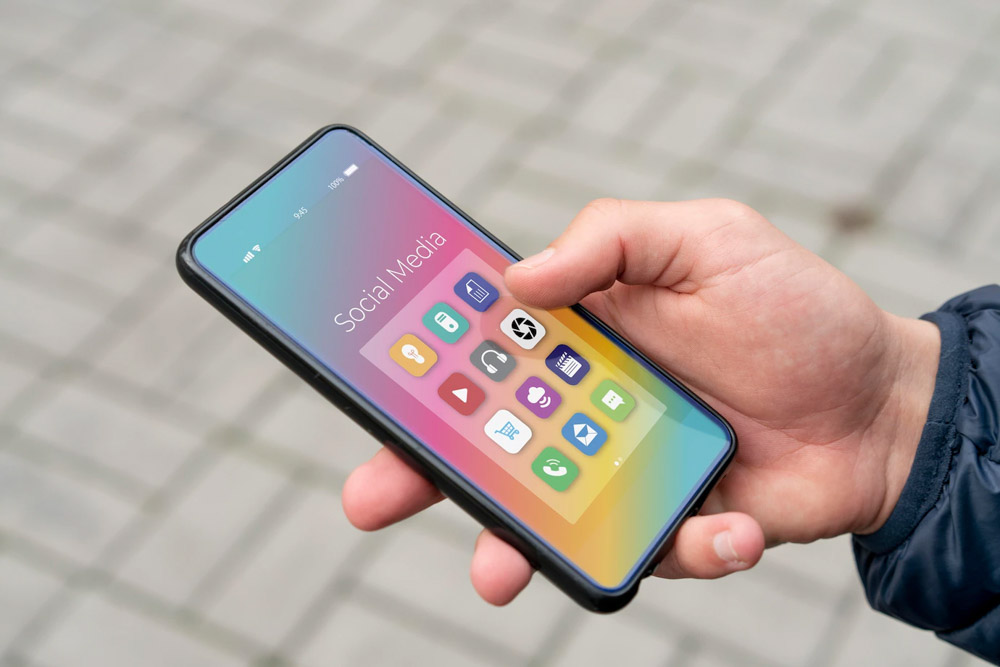
Image source: Freepik
Mobile testing is the process of testing mobile applications and websites on mobile devices. It’s a critical part of software development.
Still, despite the massive popularity of smartphones all over the world, this kind of testing is often overlooked or given less attention than it deserves. You can test several different types of software:
- Native apps – programs you can install and run natively on the device.
- Responsive web apps – mobile web apps you can access through a mobile browser or install as a PWA (Progressive Web App).
- Hybrid apps – a middle ground between the two options above. You can distribute them in application stores, but they require a mobile browser to work.
Why is mobile testing important?

Image source: Freepik
Mobile testing is essential because it allows you to identify potential bugs and performance issues and ensure that your apps function correctly on various devices.
You can start with mobile testing for the following purposes:
- Optimizing usability and accessibility – mobile testing helps ensure that your mobile app or website is usable and accessible to your users.
- Ensuring compatibility with different devices – it can be challenging for mobile app developers. An iPhone 6 can run an app designed for an iPhone 5 but can’t run an app designed for an iPhone 4S. The same is valid for operating systems. You must test your app on multiple devices and systems to determine whether it works.
- Ensuring safety and security – mobile testing also ensures that mobile applications are safe for users. For example, some games can cause epilepsy due to flashing screens, and it’s essential to identify such issues before the launch. Also, some apps can ask people to do things that put their cybersecurity at risk.
- Guaranteeing good performance and stability – mobile testing is also a great way to ensure excellent app performance and stability.
- Identifying bugs and issues – mobile testing will also allow you to discover problems with your solution, such as software bugs. You can then fix them before you launch your product.
Now that you know what you can achieve with mobile testing let’s focus on the types of tests you can conduct.
10 types of mobile application testing

Image source: Freepik
There are many different methods for testing mobile applications. Here are some of the most important tests you can use to evaluate your solution.
1. Functional testing
You run functional tests to determine whether the application has every necessary functionality and whether it works as you intended. It’s one of the most important types of mobile application testing, and it’s usually the first test method teams use to conduct their research.
It’s understandable, as many users will look for a different solution if an app they’ve downloaded doesn’t work well enough.
2. Compatibility testing
The main reason to conduct compatibility tests is to determine how well your application works with different devices, hardware configurations, and operating systems. It also allows you to check whether you can integrate your app with other solutions – for example, applications created by other companies.
It’s essential since compatibility significantly impacts the size of your potential user base. You can make the best application in your industry, but it won’t be successful if people can only use it on a small number of devices.
There are two main subtypes of compatibility tests: backward and forward. The former focuses on checking compatibility with existing, older systems and devices. The latter aims to ensure your solution will work well with new – for example, recently released or beta-tested versions.
3. Performance testing
Performance measures how responsive an application is – how well and fast it reacts to the user’s actions. Everything needs to be smooth and responsive right from the start. Every click and action performed on various pages and panels has to work instantly, without delay.
It’s what people expect nowadays, and this is what you need to provide, or users will look for an alternative product.
Performance testing is all about ensuring a good outcome in this regard. You can measure hardware performance, battery consumption, API/server performance, and network performance.
Sometimes, the tests also evaluate the effectiveness of your system backup and recovery features, which is also very important, as no one likes to lose important data because of a system failure.
4. Interruption testing
You can conduct an interruption test to check how an application responds to an atypical and unexpected situation that may stop it from working as intended.
For example, imagine using a shopping app on your smartphone and suddenly getting a phone call through a completely different piece of software and in a completely unrelated matter.
Are you redirected to the app screen after the call? Is the app paused during the conversation? These are some of the questions that interruption testing tries to answer.
5. Security testing

Image source: Storage Demand
Data security is a serious problem nowadays. While not every user is aware of it, more and more people are becoming concerned with their privacy and safety while using various applications. Security testing is the way to ensure there’s nothing to worry about, making it incredibly important.
It’s the kind of testing that may make or break an application. People aren’t going to use solutions they don’t consider secure – it’s as simple as that.
6. Usability testing
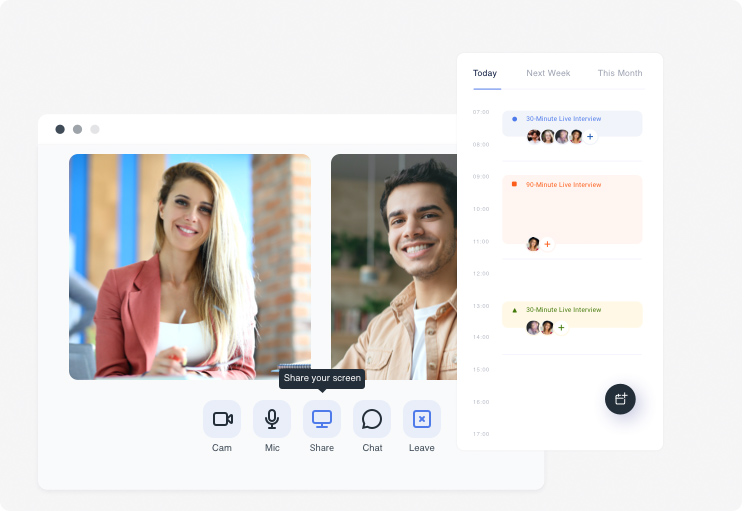
You need to provide an optimal user experience with your application. It’s often the deciding factor that makes the difference between success and failure. You can start with usability testing to ensure your solution is user-friendly and intuitive, among other things.
UX testing allows you to improve your product’s layout, information structure, and content design. You can root out users’ problems and evaluate the value and usefulness of planned features. You can also improve various aspects of the application – either before it hits the market or later on.
There’s also a subset of this method called UI testing, in which you focus on identifying problems with the graphic user interface of the application.
You can use a platform like our PlaybookUX to conduct various types of unmoderated and moderated usability tests and interviews. You can start your free trial today to see how it works.
7. Localization testing
Nowadays, many companies design their applications to work globally. Most organizations want their software to operate in various parts of the world, even if they aren’t planning expansion.
Taking advantage of the global reach offered by the Internet is an obvious choice. Still, it also comes with a caveat – users expect software that can adapt and fit their language, geographical, and cultural needs.
Because of this, localization is yet another area that you have to test. Translations of in-app content and notifications, the effectiveness of geolocation, the ability to use local currency – all these aspects of your solution can have hidden problems that you won’t find without localization testing.
Sure, they may work fine, but “may” isn’t a good word when you have to spend your budget.
8. Memory leak testing
Sometimes a program runs out of memory it needs to function correctly, which may cause it to stop working. It often happens because of a so-called memory leak – a scenario in which an application fails to clear the memory it previously used.
Rooting out code fragments that cause memory leaks is important, but you must first identify them.
Memory leak testing is a subset of performance testing. You can run the test on several devices with different memory configurations. It allows you to analyze how the app handles the memory in each case. It helps you understand what causes the problem.
9. Upgrade testing
You will need to update your app at some point, and it’s crucial to ensure everything works correctly.
- Is data retained between both versions of software?
- Do users encounter any problems with logging?
- Are new features compatible with existing ones?
- Can you update the old software version to the most recent one?
- How long does the update take?
These are all questions you can answer thanks to upgrade testing.
10. Installation testing
The crucial thing when developing a native app is ensuring that the installation process works flawlessly. Detecting errors and crashes is typically the focus, but improving the entire experience – making it more accessible and faster – can be a secondary goal.
Checklist for successful mobile app testing

Image source: Freepik
A good usability test plan is a requirement if you want your testing process to be successful. While test methods differ, you should follow a couple of simple steps for each one:
- Determine goals and metrics – before doing anything else, you first need to know what you want to achieve with the entire process and how to get the data you need.
- Specify the audience and devices – you should specify how many test participants you need to recruit and what kind of devices you’ll test on.
- Recruit participants – the next necessary step is recruiting participants, and we will outline two approaches in the following sections.
- Create test scenarios – you also need to create scenarios, questions, and tasks your users will perform.
- Conduct test – it’s time to run the test itself. You can do this manually or use an automated testing tool like PlaybookUX. The specifics will depend on the method you choose.
- Evaluate the data – you need to evaluate and analyze the acquired data in the context of your product.
- Use the gathered information – the last step is to use the data you got to eliminate problems and improve your solution in critical areas.
So, this is how you run a successful mobile test. What kind of data can you gather using these methods? Let’s discuss this in the following section.
Key data to gather from mobile testing
You should never conduct any usability test without specifying what UX metrics you want to measure.
Mobile testing is no different in this regard, though the exact data you’ll be interested in will depend on the type of test you want to run. In general, mobile testing allows you to get information regarding several vital areas:
- User engagement – you can learn whether users find value in your product. You’ll likely be interested in CSAT (Customer Satisfaction Score) or CRR (Customer Retention Rate) metrics.
- Functionality – it lets you see whether everything in your app works as it should. Task time, task success rate, and user error rate are some of the metrics to evaluate in this case.
- Performance – you can measure and optimize hardware, software, and network performance. For example, you can track load times / HTTP requests to see how fast your application loads and responds to user actions.
To run any test, you need participants. How do you find them effectively without wasting too much time and money? Read on to find out.
How to find the right testers for your mobile apps?
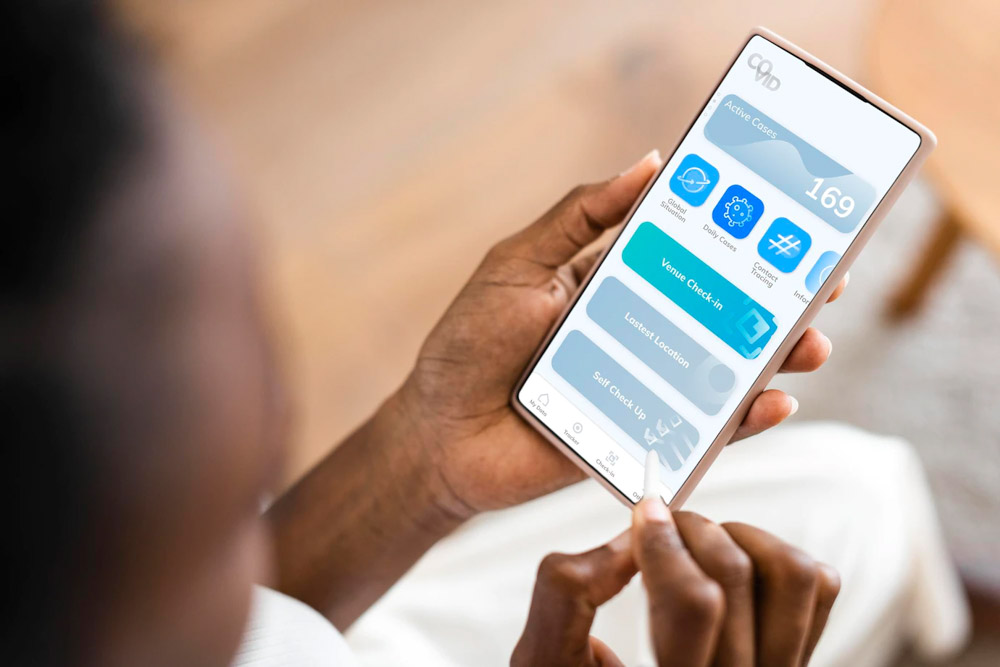
Image source: Freepik
You can approach the mobile testing process differently. You can either conduct tests manually or use automated tools like PlaybookUX or others such as UserZoom and UserTesting. Read our
UserZoom vs UserTesting comparison article to learn more about these solutions.
Depending on your chosen method, finding and recruiting test participants will look very different. In the case of manual testing, you’ll need to find the people yourself.
You’ll probably use social media and ads, and you’ll have to convince testers to participate – usually by offering them money. The good thing is that you have complete control over your test audience. The bad is that it’s pretty time-consuming and can be costly.
The most significant advantage of automated tools is the fast and straightforward process. Finding and hiring the people you need requires just a few mouse clicks – you can specify your needs, and the software takes care of the rest.
In essence, you give up some of the control but save time and money. Our PlaybookUX platform allows you to do just that, and it gives you the option to customize your target audience in many ways. You can define specifics such as age, occupation, industry, or the area people live in.
Start your 7-day free trial to see how it works.
How to conduct mobile testing with PlaybookUX
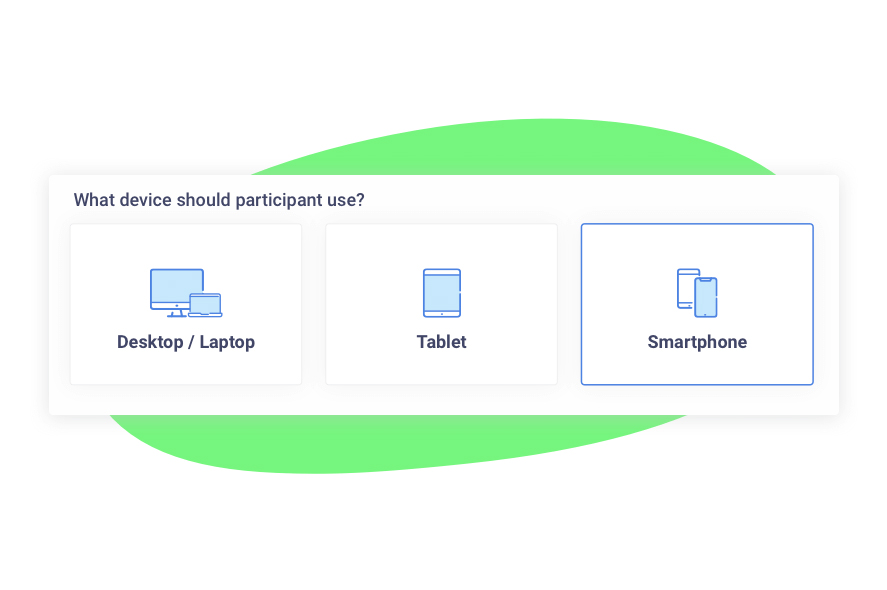
Our PlaybookUX is a video-based user research platform. You can use it to conduct mobile tests and other user research methods. Here are some examples:
- User interviews
- Prototype testing
- Concept testing
- Creative testing
- Testing web apps
- Card sorting
- Tree testing
PlaybookUX makes mobile testing easy. It works similarly to desktop/laptop testing – you can select the type of device you want to test on. You can also specify the operating system, Android or iOS.
The participants download the app, and PlaybookUX records their screen and voice while interacting with it. They can carry out a set of specified tasks and answer your questions.
Our solution helps you out by taking care of some more tedious tasks. For example, PlaybookUX can automatically schedule, record, and store sessions, saving precious time.
These recordings are automatically uploaded to your project when the session is over. You can access and analyze them whenever you want. You can also read transcriptions, display overviews, and graphs illustrating the results.
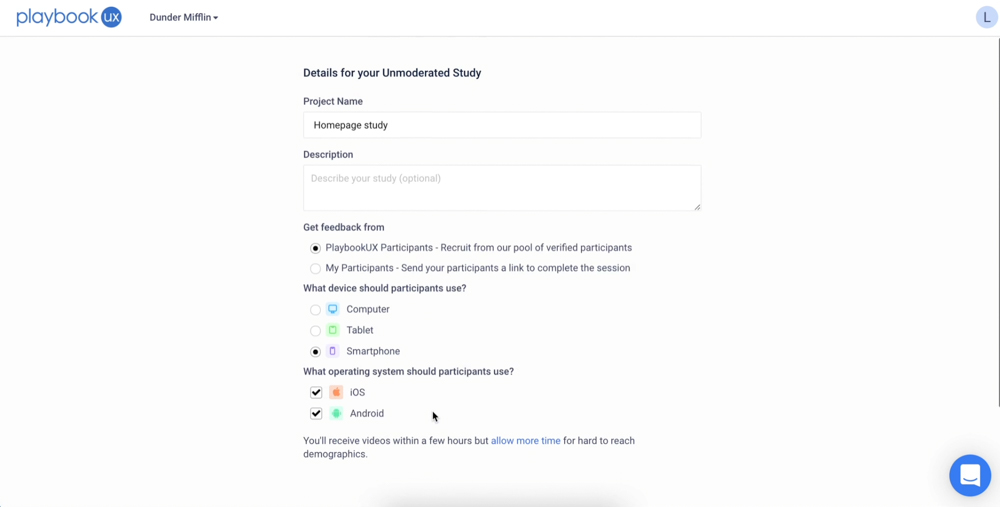
Our powerful search engine, indexing, and tagging features we offer make PlaybookUX an excellent UX research repository. Unlike EnjoyHQ or Dovetail, you don’t have to pay for an additional license to use our platform this way. It allows you to find whatever information you’re looking for quickly.
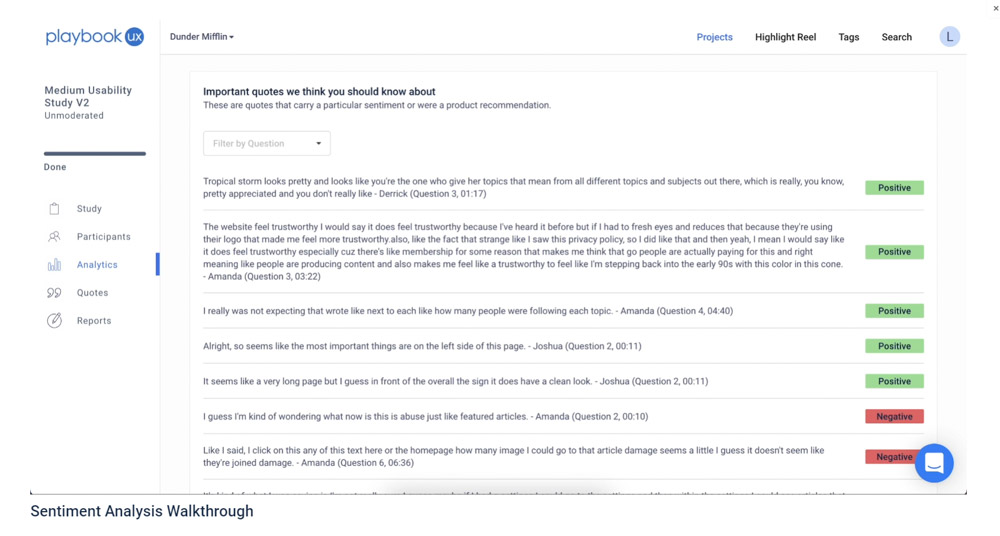
PlaybookUX helps you identify negative trends and gain valuable insights by analyzing the collected data.
For example, you might use sentiment analysis to identify positive and negative statements to determine what you should address and what people found difficult. You can easily tag themes and track these patterns by using reactions.
Mobile testing: Wrapping up
Testing mobile applications is a crucial part of the software development process.
There’s no one-size-fits-all strategy for mobile testing. It’s crucial to determine what devices your users will employ and how relevant your application is. Be sure to test on different types of devices, operating systems, and networks. The types of tests you run will determine your app’s success.
One great way to optimize this process is mobile test automation, assuming you can find the right tool. Our PlaybookUX is an efficient, video-based user research platform that allows you to conduct various tests.
It makes recruiting participants easy, automates the scheduling and recording of sessions, and helps you access essential information thanks to powerful search, indexing, and tagging features. Sign up on the spot and check it out during a 7-day free trial.
Mobile testing: FAQ
There are many questions regarding mobile testing on the Internet. Here are answers to some of the most popular ones.
What is meant by mobile testing?
Mobile testing is the process of testing an application or website on a mobile device, such as a smartphone or a tablet. It’s an essential step in the app development process.
It ensures that your solution functions properly and provides an optimal user experience on different devices and operating systems. You can also identify bugs, test your app’s performance and features, and optimize it for as many screen sizes as possible.
What is mobile testing in QA?
QA teams perform mobile testing to evaluate the functionality of mobile apps on real-world devices.
The process includes a variety of tests that measure how well an app performs at different device configurations, including versions with full-size and smaller screens and operating systems with different types of hardware.
In addition to checking whether an app correctly renders on a specific device model, mobile testers can check for common bugs such as crashes or poor performance on slower networks.
What are the types of mobile testing?
There are many different types of mobile testing:
- Functional testing
- Compatibility testing
- Performance testing
- Interruption testing
- Security testing
- Usability testing
- Localization testing
- Memory leak testing
- Upgrade testing
- Installation testing
You use each of these test methods for different purposes. They let you analyze how your application interacts with the hardware it runs on and how users perceive it.
How can I do mobile testing?
You can efficiently conduct mobile testing using automated mobile testing tools like our PlaybookUX. It’ll allow you to find participants and simplify the entire process. Start a 7-day free trial and test all PlaybookUX features if you haven’t already.
Speak to high quality people
